Ertach Kernow - Cury & Gunwalloe Cornish churches endure despite ravages of time
A couple of weeks ago I enjoyed a splendid day out on what started as a wet dismal day caught up in tourist traffic. I was destined for Cury a small widely dispersed settlement beyond Helston to participate in the dedication of the new Cury & Gunwalloe Old Cornwall Society banner. A fairly new society just two years old they unveiled their new banner a visual masterpiece of workmanship utilising iconography from around their area of Cornwall. What a friendly lovely group of people make up this society and we were treated to a locally made Cornish pasties for lunch.
Once the event was over it was time to take advantage of improved weather to have a look around the district especially the two churches, Cury’s dedicated to St Corentine and Gunwalloe’s to St Winwaloe. Both Cury and Gunwalloe are ancient settlements and are included in the Domesday Book of 1086. Cury is named as Chori and Gunwallow was part of the Manor of Winnianton held by the king. This was a valuable holding covering a large area and including many hamlets and villages around the Lizard.
Both churches were previously a manorial churches to the manor at Winnianton. In 1246 they were held by Richard Earl of Cornwall who gave them to Hailes Abbey in Gloucestershire, which he had founded that year. Richard was the wealthiest man in England deriving much of his income from Cornwall and taxes on tin. He could afford to divert some of his income to maintain his new abbey at Hailes where he was buried after his death.
Originally constructed in the 12th century St Corentine was rededicated by Walter Bronescombe, Bishop of Exeter, on 1st September 1261, perhaps pointing to some additional work being carried out beforehand. Further construction during the 15th century saw the church expanded with the addition of a north aisle, porch and tower. The 19th century saw reconstruction and repairs including a hammer beam roof although some of the 15th century roof remains in the north aisle as do some 15th century windows. The font is 12th century granite with some 19th century serpentine repairs and the historic family type pews were replaced in the 19th century.
Sadly, the church was closed so we were unable to enjoy the internal historic architecture and the various changes made throughout the centuries, we did have a good look around the outside. The 19th century reconstruction came about through damage to the church buildings through strong storms during 1872/73. It was mainly the work of the Rev Alfred Hayman Cummings who had left to become vicar of St Paul’s Church in Truro before the work at Cury was finally completed. Reverend Cummings organised the reconstruction himself, making the necessary drawings and using local tradesmen to carry out the work. The total cost was reported in 1874 to have been £900 about £105.000 today. Once completed the Bishop of Exeter reopened the church on 16th July 1874.
One of the outcomes of the repairs and reconstruction were discoveries that had been covered up over the centuries especially by inches of whitewashed plaster. Some of these desecrations had taken place firstly during the reign of Edward VI following the death of Henry VIII. Perhaps even more severely were those during the 17th century Commonwealth period when fanatical puritans destroyed many church features throughout Cornwall and England.
During the 19th century many churches were repaired and reconstructed, sadly not always sympathetically, with many historical features and alterations recorded in stone destroyed. However, it appears from his and other writings that Reverend Cummings was a sympathetic in recording and maintaining historic features and even exposing them as such. He writes; ‘It was then in the thorough examination of the whole fabric, that one after another objects of interest were discovered, which not only evidenced how ancient the building is, but suggested many questions of interest to the thoughtful enquirer as to the records of past ages now remaining walled up beneath and covered by the monstrous plaster coats worn by so many of our country churches, as utterly ugly as was Cury, in all their deformity of paint and whitewash, but only requiring to be stripped of their dirty skin and scraped to the bone to yield as satisfactory a reward, needing only to be seen to be appreciated.’
Interesting external features include a hagioscope, a small low window, used by undesirables or lepers to view into the church, often called a leper window or lychnoscope when installed in an external wall. There are only eleven of this type of church window remaining in Cornwall today. The drawing of this was made by J T Blight for his book Churches of West Cornwall published in 1865 showing internal and external views.
During the renovations doorways were uncovered along with smashed statuary buried within stairways. Two skeletons were also found within the rubble including one with a femur 20.5 inches long, whose height can be calculated to nearly six and a half feet, very tall for the period. Various other discoveries were made by the Reverend Cummings making St Corentine a most interesting church. Charles Henderson an outstanding Cornish historian during the early 20th century certainly thought so. He also expressed interest in a missing £40 that was bequeathed by John Skewys for the construction of a south aisle that was never built, today worth over £33,000. On a future visit I look forward to being able to gain access.
The cross at the gateway to St Corentine is some 9 feet tall. Reverend Cummings mentions that around 1850 it was found detached from its base and replaced to its current position close to the gate, the original position being unknown. For two faces above one of the windows I can find no immediate references, are these green men perhaps without the usual surrounding foliage?
On then to Gunwalloe visiting the beach and then the church and cove. This shoreline has seen many wrecks over the centuries and waves crashing onto the sands taking many lives. Reverend J Charles Cox when visiting during a storm in 1876 saw huge amounts of heavy spray being dashed over all three of the gabled roofs and falling on the north side. Mentioned in the 13th century tradition says the church was erected by its founder as an offering due to being saved from a shipwreck.
St Winwaloe Church is a relatively small church 54 feet by 43 feet with a strangely detached tower some 14 feet from the church, built into the adjoining rock that forms a large part of the west, north and south walls. It’s an example of a three-hall church not having been like most Cornish churches of cruciform design. In his Churches of West Cornwall published in 1865 Cornish archaeological artist J T Blight reported that ‘internally it is coated with whitewash and sadly requires restoration’. Perhaps even sadder is the fact that it was restored in 1869-1870 with architect Edmund H Sedding later writing that it ‘has lost much of its old charm owing to an unsympathetic ‘restoration’’. Confirmed by Reverend John Charles Cox an influential local historian and prolific ecclesiastical author who stated in 1912, ‘a distinctly bad restoration when much new work was unnecessarily introduced.’ Sedding comments that apart from the font there are no other remnants of the Norman church and mainly 15th century workmanship remaining.
Looking at St Winwaloe’s Church with an untrained eye the romantic position of the church, it’s strange layout and the beautiful views from it make one less critical than perhaps Sedding or Cox were in their writing. With its position so close to the shoreline we can only hope that it will survive long into the future. No doubt a return to this interesting area of Cornwall is on the cards to be shared with readers.
Our round trip to Cury and Gunwalloe and back wasn’t over, and we had a side trip to make on the way home via Truro. That will need to wait until next week to give it a fair account.
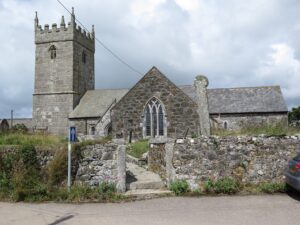
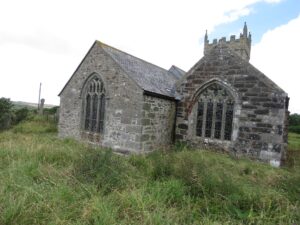
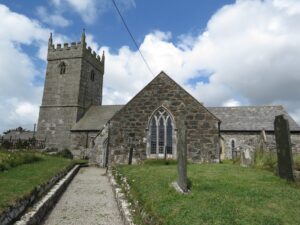
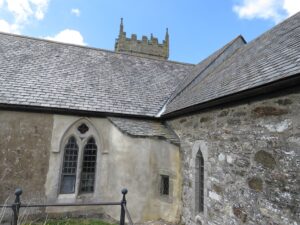
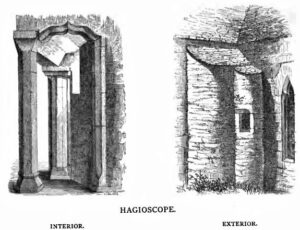
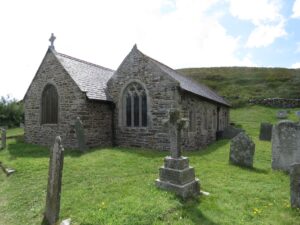
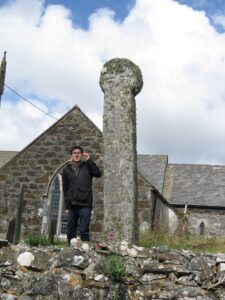
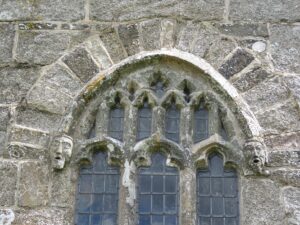
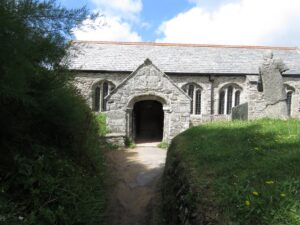
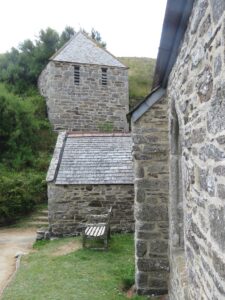
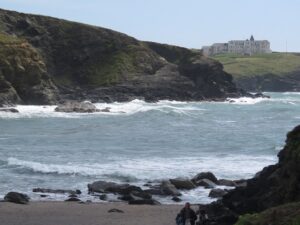
![[61] Voice - Ertach Kernow- 250821A - Churches endure [S] Ertach Kernow- Churches endure (Cury & Gunwalloe)](https://www.cornwallheritage.com/wp-content/uploads/2021/08/61-Voice-Ertach-Kernow-250821A-Churches-endure-S-232x300.jpg)
![[61] Voice - Ertach Kernow- 250821B - Churches endure [S] Ertach Kernow- Churches endure (Cury & Gunwalloe)](https://www.cornwallheritage.com/wp-content/uploads/2021/08/61-Voice-Ertach-Kernow-250821B-Churches-endure-S-229x300.jpg)